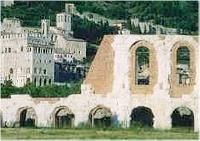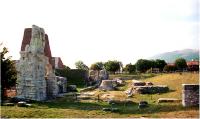Gubbio -
Gubbio Under the Roman Empire
 |
| Anfiteatro e veduta di Gubbio - © William P. Thayer 2000 |
A clear idea of how society functioned in the “Tota Ikuvina” has been inscribed on the renowned Gubbio Tablets, which are kept in the Palazzo dei Consoli. These tablets are composed of seven bronze slabs of varying size, displaying inscriptions (even on both sides in some cases) in the ancient Umbrian language. Five inscriptions (2nd century BC) are in Etruscan characters, while two further inscriptions dating from between the 2nd and 1st century BC are in Latin that has been adapted to the language. The slabs were unearthed near Scheggia in 1444 and bought by the Comune of Gubbio in exchange for grazing rights. As well as being the most complete example of the ancient Umbrian language available to us today, the tablets are arguably the most important ritual text from the Classical Age to have survived intact. The inscriptions on the slabs provide a precise description of the religious ceremonies and sacrifices carried out by the Atiedii brotherhood, as well as references to the triple deity Grabovian cult that included Jove, Mars and Vophion - later known as the Quirine cult in Roman times and eventually substituted by the cult of Minerva. There is mention of twelve corporations gathered together into three groups: the ‘natine petrunia’ (masons), ‘natine vuhicia’ (carriers) and ‘sehmenies tekufies’ (traders and artisans). The city’s three gates are also mentioned: Trebulana, Tessenaca and Vehia. Only the Vehia gate has so far been identified, although there is some doubt as to the authenticity of this claim. Allegedly from between the 4th and 3rd century BC, the arch of Porta Vehia was remodelled in the Middle Ages. The slabs also mention enemy tribes and people such as the Etruscans (etruskus), the inhabitants of Terni and the Valnerina valley (naharskus), and the “accursed” citizens of Gualdo Tadino (Tarsinater), who the gods are called upon to exterminate.
 |
| Rovine romane - © William P. Thayer 2000 |
 |
| Anfiteatro Romano - © William P. Thayer 2000 |
The Roman mausoleum stands nine metres high and has been completely stripped of its exterior covering. The burial chamber in the interior measures 6.30m x 4.72m and is built in regular slabs topped by a barrel vaulted ceiling. Opinion is divided as to whom the mausoleum was intended for. Some sustain that it was the sepulchre of Genzius, king of the Illyrians, who was imprisoned in Gubbio after he surrendered to the Romans. Others believe the building to be the tomb of a certain Pomponius Grecinus.
© Copyright 2001-2025
by Umbriaonline.com
SCG Business Consulting S.a.s. di Giacomelli E. & C. - Internet Advertising Division - © 2001-2025 All Rights Reserved - P.IVA 01675690562